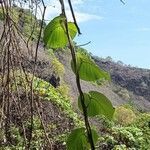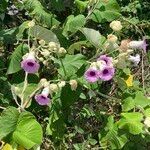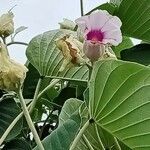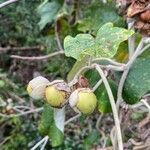| Therapeutic use
|
Antiviral agents (fruit), Anti-bacterial agents (leaf), Antifungal agents (leaf), Anti-inflammatory agents (leaf), Antinematodal agents (leaf), Eczema (leaf), Emollients (leaf), Fertility agents (leaf), Counterirritant (leaf), Nervous system diseases (leaf), Pruritus (leaf), Skin diseases (leaf), Urinary bladder calculi (leaf), Wound healing (leaf), Wounds and injuries (leaf), Anti-inflammatory agents (root), Antirheumatic agents (root), Aphrodisiacs (root), Ascites (root), Bronchitis (root), Colic (root), Common cold (root), Cough (root), Diabetes mellitus (root), Diuretics (root), Dysentery (root), Dyspepsia (root), Fever (root), Gonorrhea (root), Hemiplegia (root), Nervous system diseases (root), Pharyngitis (root), General tonic for rejuvenation (root), Synovitis (root), Syphilis (root), Tuberculosis, pulmonary (root), Antifungal agents (seed), Cardiovascular system (seed), Hypotension (seed), Parasympatholytics (seed), General tonic for rejuvenation (seed), Alterative (unspecified), Diarrhea (unspecified), Dysentery (unspecified), Poultice (unspecified), Rheumatism (unspecified), Skin (unspecified), Smallpox (unspecified), Sudorific (unspecified), Suppurative (unspecified), Syphilis (unspecified), Tonic (unspecified), Boil (unspecified), Nerves (unspecified), Sore(Foot) (unspecified), Rubefacient (unspecified), Stomach (unspecified), Medicine (unspecified), Anodyne (unspecified), Anemia (unspecified), Anorexia (unspecified), Antifungal agents (unspecified), Anti-infective agents (unspecified), Anti-inflammatory agents (unspecified), Anti-obesity agents (unspecified), Antirheumatic agents (unspecified), Aphrodisiacs (unspecified), Appetite stimulants (unspecified), Arthritis (unspecified), Ascites (unspecified), Asthenia (unspecified), Brain diseases (unspecified), Bronchitis (unspecified), Cardiotonic agents (unspecified), Cerebrovascular circulation (unspecified), Colic (unspecified), Cough (unspecified), Diabetes mellitus (unspecified), Diuretics (unspecified), Dyspepsia (unspecified), Eczema (unspecified), Edema (unspecified), Disorder of ejaculation (unspecified), Emaciation (unspecified), Emollients (unspecified), Erectile dysfunction (unspecified), Expectorants (unspecified), Flatulence (unspecified), Foot ulcer (unspecified), Furunculosis (unspecified), Gonorrhea (unspecified), Heart diseases (unspecified), Hemiplegia (unspecified), Hemorrhage (unspecified), Hoarseness (unspecified), Inflammation (unspecified), Counterirritant (unspecified), Laxatives (unspecified), Leukorrhea (unspecified), Nervous system diseases (unspecified), Nootropic agents (unspecified), Pruritus (unspecified), General tonic for rejuvenation (unspecified), Skin diseases (unspecified), Stomach diseases (unspecified), Synovitis (unspecified), Tuberculosis (unspecified), Ulcer (unspecified), Urination disorders (unspecified), Wounds and injuries (unspecified), Gonorrhea (whole plant), Ulcer (whole plant), Urination disorders (whole plant)
|










